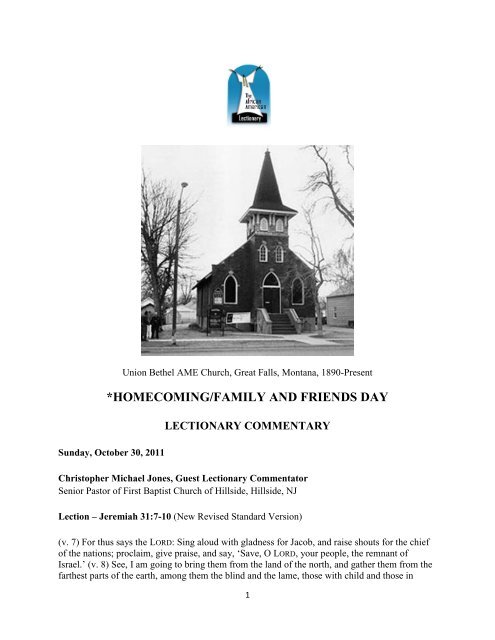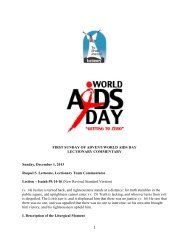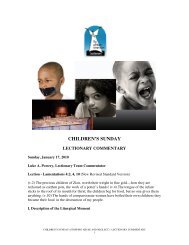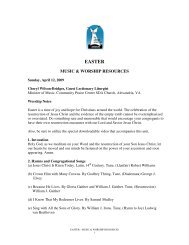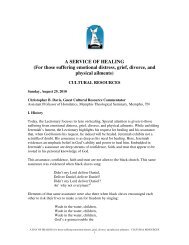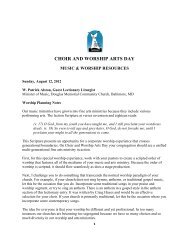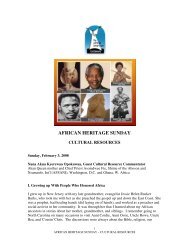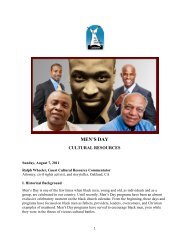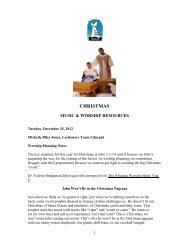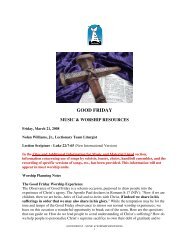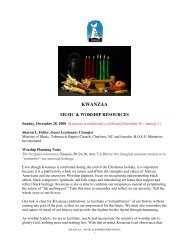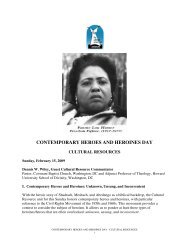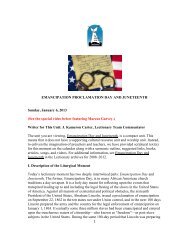homecoming/family and friends day - The African American Lectionary
homecoming/family and friends day - The African American Lectionary
homecoming/family and friends day - The African American Lectionary
You also want an ePaper? Increase the reach of your titles
YUMPU automatically turns print PDFs into web optimized ePapers that Google loves.
Union Bethel AME Church, Great Falls, Montana, 1890-Present*HOMECOMING/FAMILY AND FRIENDS DAYSun<strong>day</strong>, October 30, 2011LECTIONARY COMMENTARYChristopher Michael Jones, Guest <strong>Lectionary</strong> CommentatorSenior Pastor of First Baptist Church of Hillside, Hillside, NJLection – Jeremiah 31:7-10 (New Revised St<strong>and</strong>ard Version)(v. 7) For thus says the LORD: Sing aloud with gladness for Jacob, <strong>and</strong> raise shouts for the chiefof the nations; proclaim, give praise, <strong>and</strong> say, „Save, O LORD, your people, the remnant ofIsrael.‟ (v. 8) See, I am going to bring them from the l<strong>and</strong> of the north, <strong>and</strong> gather them from thefarthest parts of the earth, among them the blind <strong>and</strong> the lame, those with child <strong>and</strong> those in1
labour, together; a great company, they shall return here. (v. 9) With weeping they shall come,<strong>and</strong> with consolations I will lead them back, I will let them walk by brooks of water, in a straightpath in which they shall not stumble; for I have become a father to Israel, <strong>and</strong> Ephraim is myfirstborn. (v. 10) Hear the word of the LORD, O nations, <strong>and</strong> declare it in the coastl<strong>and</strong>s far away;say, „He who scattered Israel will gather him, <strong>and</strong> will keep him as a shepherd a flock.‟I. Description of the Liturgical MomentIn the <strong>African</strong> <strong>American</strong> church, “Homecoming/Family <strong>and</strong> Friends Day” means much more tothe parishioner than a <strong>day</strong> when relatives <strong>and</strong> acquaintances are simply invited to attend a specialchurch service in their honor. To the contrary, “Homecoming” or “Family <strong>and</strong> Friends Day”st<strong>and</strong>s as a sacred <strong>day</strong>. It is a <strong>day</strong> within the church calendar year for which members travel fromfar <strong>and</strong> near. Friends, relatives, acquaintances, <strong>and</strong> community associates return to their “Homechurch” on this <strong>day</strong> to testify to the faithfulness of God <strong>and</strong> also to witness the new things beingorchestrated by God in the life of their “Home church.” This annual sojourn is made by many inthe <strong>African</strong> <strong>American</strong> church because “Homecoming/Family <strong>and</strong> Friends Day” reconnects itsparishioners to a story. Underneath all the festive dinners, scheduled sports events, fund raisingactivities, fellowships, choir rehearsals, <strong>and</strong> ad hoc <strong>family</strong> reunions exists a narrative detailingthe compassionate activity of a God who has faithfully sheltered countless generations from thepresence of evil. For the sojourner committed to this sacred <strong>day</strong>, “Homecoming/Family <strong>and</strong>Friends Day” not only reunites a particular people with their God, but also reunites a church withits liberating mission in Jesus Christ.II. Biblical Interpretation for Preaching <strong>and</strong> Worship: Jeremiah 31:7-10Part One: <strong>The</strong> Contemporary Contexts of the InterpreterI love the occasion of “Homecoming/Family <strong>and</strong> Friends Day.” As I am completing thiscommentary the church I serve <strong>and</strong> I are preparing to embark upon a weekend summer trip toElizabeth City, North Carolina. I have been invited to uplift the New Sawyer‟s Creek MissionaryBaptist Church congregation as guest preacher for their annual “Homecoming” celebration.Chartered buses have been reserved. Hotel rooms have been secured. Adults are already pickingout their road trip outfits <strong>and</strong> the children have already claimed the victory in the church-widevolleyball contest. Members of the New Sawyer‟s Creek Missionary Baptist Church havealready formed their committees to receive us. Dinners are being prepared. Games are beingscheduled. Volunteers have already signed up <strong>and</strong> the pastor is pumping up the event from thepulpit.Even though the First Baptist Church of Hillside is a northern congregation geographicallyspeaking, its members are predominantly first- <strong>and</strong> second-generation <strong>African</strong> <strong>American</strong>migrants from the Deep South, <strong>and</strong> can identify with the underlying themes of the New Sawyer‟sCreek Missionary Baptist Church annual “Homecoming” celebration. As first- <strong>and</strong> secondgenerationmigrants of the Deep South, FBC members know what it‟s like to long for the chanceto go “home” <strong>and</strong> be “comforted” by the God of their childhood years. <strong>The</strong> idea of going “home”resonates well with the <strong>African</strong> <strong>American</strong> church. In this instance, the two churches comingtogether as one suggests that God still actively summons people to gather in God‟s name.2
Through the memories of childhood baptism, that first Communion, that first Sun<strong>day</strong> schoollesson, <strong>and</strong> that first church picnic, God rejoins the gathered community of sojourners <strong>and</strong> bringsafresh a new sense of covenant into the hearts of God‟s people. God‟s calling at “Homecoming”enables the faithful to bear witness to a real experience of shelter, liberation, <strong>and</strong> an assurancethat God is still leading God‟s people into the future.Part Two: Biblical CommentaryThis “Homecoming” or “Family <strong>and</strong> Friends Day” text should remind the reader of the ways inwhich God‟s grace works within the <strong>family</strong> of God. By God‟s grace the people of Israel inherit anew covenant that enables them to progress in the world <strong>and</strong>, though scattered, reclaim theirspiritual inheritance in a way they never could by their own efforts. For the author of the text, theway “home” is described as a continuing repentance <strong>and</strong> remembering of the LORD. Throughcareful reflection <strong>and</strong> introspection the people of Israel will rediscover their place in the plans ofGod. It may seem as if the adversities of life have carried Israel far from the presence of God.However, the LORD declares, Israel is still God‟s chosen people. God promises to sustain theirlives in the midst of adversity <strong>and</strong> bring them back home, the common place of their ancestors.It should be noted that the author of the text does not deny the paradoxical nature in which thisgood news is being presented. <strong>The</strong> people of God are indeed scattered <strong>and</strong> have no apparentreason to shout concerning God‟s faithfulness in the l<strong>and</strong>. Persecution under the tyranny of theAssyrian empire is believed to have reached its height. Israel has become faint. God‟s divineprotection seems like a distant memory, <strong>and</strong> God‟s promises of redemption have been longforgotten. Once considered the apple of God‟s eye, Israel has now become a stench to the nations<strong>and</strong> is believed by many to have been disowned by their LORD.It is with this backdrop in mind that we witness the prophetic voice of Jeremiah penetrate thedespair of God‟s people. Jeremiah promises that the <strong>day</strong> of liberation is at h<strong>and</strong> where God‟speople will be set free <strong>and</strong> returned to their spiritual “home.” Much like the <strong>African</strong> <strong>American</strong>church in the south during the Civil Rights Era, Israel will be protected from its oppressor <strong>and</strong> itssurvivors will be reunited with the l<strong>and</strong> of their ancestors. Jeremiah declares that life will breatheagain with great gatherings of worship. Israel‟s exiled residents will shout great „hosannas‟ intheir temple of old. <strong>The</strong> weary men, women, <strong>and</strong> children of Israel will remember their God oftimes past, <strong>and</strong> they will long to return to the place of their great “Homecoming.”<strong>The</strong> author of the text wants the reader to know that this <strong>day</strong> will happen. From the north <strong>and</strong> thefar parts of the earth the people of God will come home. <strong>The</strong>y will come blind, broken, <strong>and</strong>laboring; tears will be mingled with cries of joy, but God‟s love will be experienced by them,like a child reuniting with a long-lost parent.This message is given to the people of Israel, but should also be received by the Church to<strong>day</strong>.<strong>The</strong> LORD promises to redeem the suffering <strong>and</strong> the oppressed. All who turn to the LORD willbe filled with joy <strong>and</strong> will be pointed towards their spiritual home in this life <strong>and</strong> the next.Though social media like Facebook <strong>and</strong> Twitter are now being mistakenly used to replace themore traditional modes of communal gathering in the <strong>African</strong> <strong>American</strong> church, none can everreplace the blessing of a true “Homecoming.”3
It is at the “Homecoming” where the people of God see the faithful h<strong>and</strong> of the LORD in theirmidst <strong>and</strong> are able to ascertain how God ransomed them from the h<strong>and</strong> of an oppressor mightierthan they. At the “Homecoming” gathering, <strong>and</strong> in the face of oppressors, voices are lifted insong. Praises are declared in the atmosphere. Words of comfort are shared among the people.Children are reconnected with their spiritual lineage. This is all done to declare a people‟s faithin their God.Much like Jeremiah, a seasoned hosting pastor will comm<strong>and</strong> an attitude of exaltation to beexpressed by those gathered at a “Homecoming” celebration. This call to radical exaltation runscounter to the trends of culture in that it empowers God‟s people to defy the effects of arecession, racial <strong>and</strong> gender discrimination, poverty, joblessness, incarceration, drug abuse, <strong>and</strong>violence in the community. To the contrary, God‟s people are reminded at the “Homecoming” bythe pastor or guest preacher that the righteous will not be denied their inheritance. Though theymay be scattered in different parts of the world, the people of God will live <strong>and</strong> receive theblessings of the LORD much like their ancestors.In this regard, the “Homecoming” or “Family <strong>and</strong> Friends Day” celebration serves two purposes.It re-centers the people of God in their remembering of the LORD who kept them in years past. Italso clarifies God‟s will for the future of the “Home church” where the people have gathered. Inthe <strong>African</strong> <strong>American</strong> church tradition, special offerings are raised to support the mission of the“Home church” during “Homecoming.” New ministries are ignited. New leaders are oftenidentified <strong>and</strong> charged to carry out the vision that nurtured previous generations. Sometimes newvisions are birthed out of the “Homecoming” celebration.In the gathering we also find a challenge from God to not forsake “the l<strong>and</strong>mark,” but to keep iterect for the benefit of future generations (Proverbs 22:28).CelebrationWe celebrate the faithfulness of God <strong>and</strong> the assurance of God‟s ways. In a world where the tenpointplan to success has become the more common option of choice for daily living,“Homecoming” reminds us that God‟s ways of old still present the best option for daily living.“Homecoming” also serves as the event where the people of God are comforted <strong>and</strong> uplifted bythe One who has always been with us; this is the posture of the Church in worship.Descriptive Details<strong>The</strong> descriptive details of this passage include:Sounds: <strong>The</strong> sudden shouting, weeping, <strong>and</strong> exalted praise of adults <strong>and</strong> children entering intothe l<strong>and</strong> their ancestors called home;Sights: <strong>The</strong> priests waving their h<strong>and</strong>s over the heads of the people as they enter the temple toexperience their first “Homecoming” celebration; <strong>and</strong>4
Smells: <strong>The</strong> smell of incense in the sanctuary as the priests prepare their offerings to the LORD;the smell of fresh olive oil mixed with frankincense <strong>and</strong> myrrh as the lotion of choice to smooththe chaffed skin of a people who just completed a long tiring journey back home to theirhomel<strong>and</strong>.III. Suggestions to Help You Prepare for Homecoming/Family <strong>and</strong> Friends DaySee the cultural resource unit <strong>and</strong> the worship unit for many other great ideas.Books to Read Prior to the ServiceAndrews, Dale P. Practical <strong>The</strong>ology for Black Churches: Bridging Black<strong>The</strong>ology <strong>and</strong> <strong>African</strong> <strong>American</strong> Folk Religion. Louisville, KY: Westminster JohnKnox Press, 2002.Evans, James H. We Have Been Believers: An <strong>African</strong>-<strong>American</strong> Systematic<strong>The</strong>ology. Minneapolis, MN: Augsburg Press, 1992.Franklin, John Hope, <strong>and</strong> Alfred A. Moss Jr. From Slavery to Freedom: AHistory of <strong>African</strong> <strong>American</strong>s. New York, NY: McGraw-Hill, 1994.Frazier, E. Franklin, <strong>and</strong> C. Eric Lincoln. <strong>The</strong> Negro Church in America/<strong>The</strong>Black Church Since Frazier: (Sourcebooks in Negro History). New York, NY:Schocken Books, 1974.5
Harris, James H. Pastoral <strong>The</strong>ology. Minneapolis, MN: Augsburg Press, 1991.Hughes, Langston <strong>and</strong> Milton Meltzer. A Pictorial History of the Negro inAmerica. New York, NY: Crown Publishers, 1956.Lincoln, C. Eric, <strong>and</strong> Lawrence H. Mamiya. <strong>The</strong> Black Church in the <strong>African</strong><strong>American</strong> Experience. Raleigh, NC: Duke University Press, 1990.Cooper-Lewter, Nicholas <strong>and</strong> Henry H. Mitchell. Soul <strong>The</strong>ology: <strong>The</strong> Heart of<strong>American</strong> Black Culture. Nashville, TN: Abingdon Press, 1991.6
Links <strong>and</strong> VideosBlack families have long coupled their return to the <strong>family</strong> “home” church with a <strong>family</strong>reunion. Enjoy the speech titled “Take Your Place” from the movie Madea‟s FamilyReunion, Tyler Perry, director.YouTube: http://www.youtube.com/watch?v=pk8Bf5LWFPg*<strong>The</strong> song that accompanies to<strong>day</strong>‟s image is titled “<strong>The</strong> Old L<strong>and</strong>mark,” which was written byWilliam Herbert Brewster. Here is it sung by Clara Ward <strong>and</strong> the Clara Ward Singers.7


